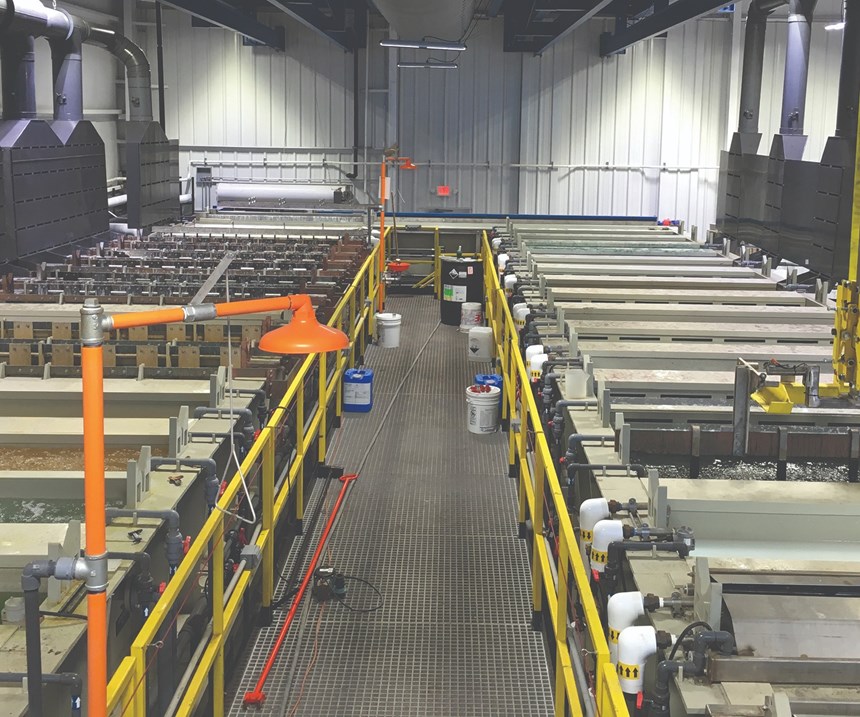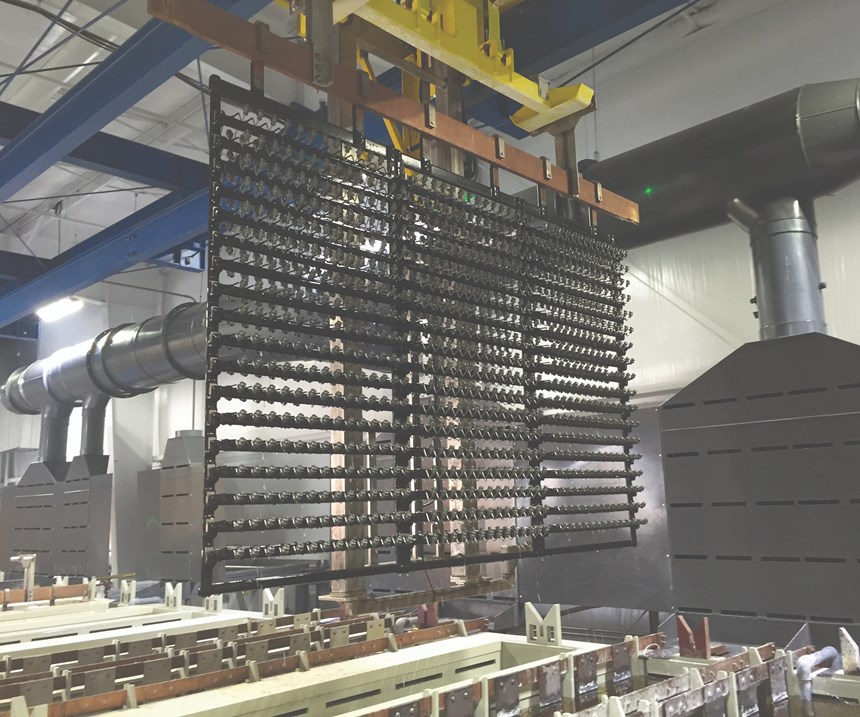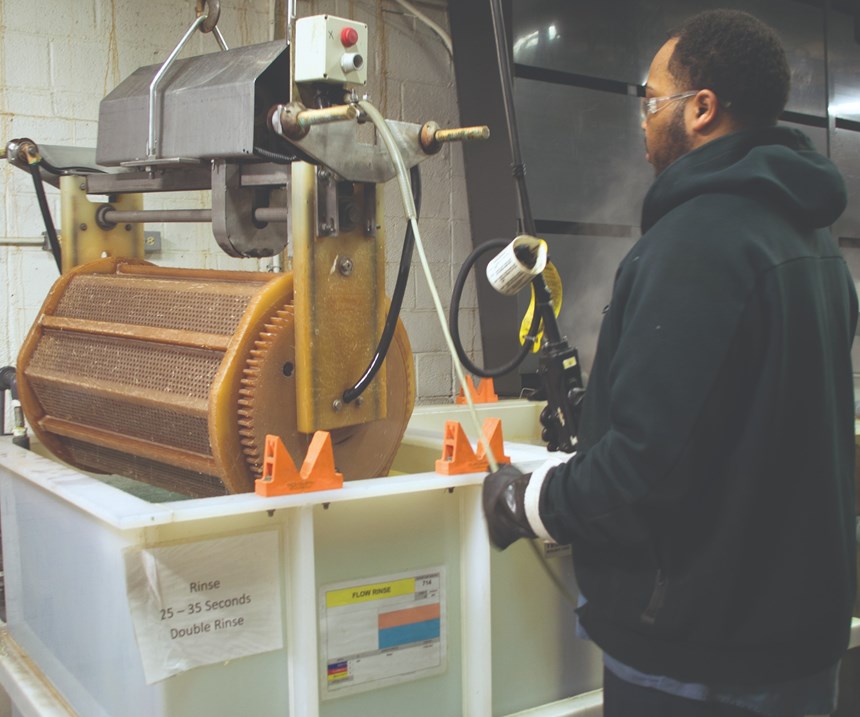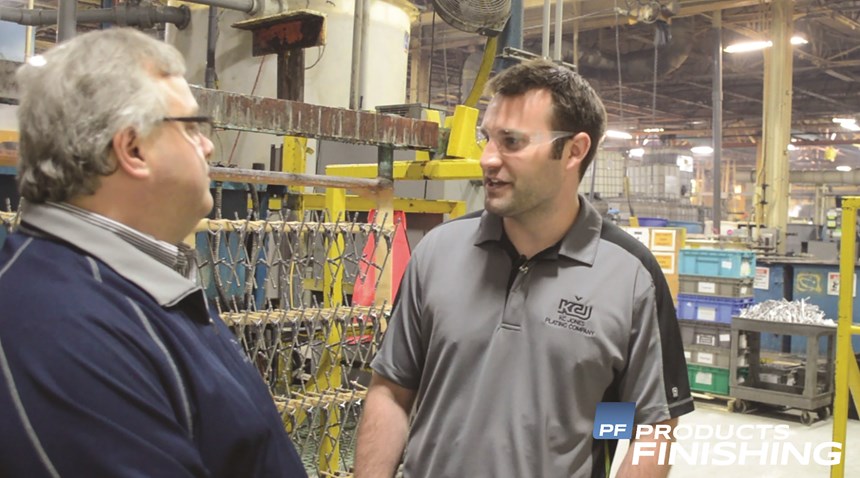Speed is everything in the electroplating industry. It’s all about how quickly you can move parts through a line and how fast you can get them to meet first-pass inspection. Master the speed factor, and most shops will be around for decades or more.
For KC Jones Plating Co., speed is relative, however. In the first 30 years after the company was founded in 1955 by Ken Jones, Al Sayers and Robert A. Burger in Hazel Park, Michigan, the pace was consistent and predictable. They added an adhesive and sealant division in the auto-heavy region in the 1960s and bought a brazing company in the 1970s as their methodical expansion plan progressed. In the late 1980s, Burger’s son Bob took over sole ownership from his father and the partners, and he later purchased the assets of a second plating shop in Michigan to expand KCJ’s capabilities.
Featured Content
It was 23 years before another expansion, this time in 2003, when the company expanded to a third location, purchasing C&R Plating in Columbia City, Indiana.
Growth over the first 60 years might be considered gradual, but the past two years have been a whirlwind for KCJ, as the management team has moved swiftly in expanding the company’s presence south of the border into Mexico. In 2016, the company opened its fourth facility, KC Jones Galvanoplastia, in Apodaca, Nuevo Leon, near Monterrey.
Bob Burger realizes KCJ is no longer his father’s plating shop.
“We are a very different operation than we were even just a few years ago,” he says. “The big thing is we have a lot more coordination at the various plants, whether it be here in Michigan or Indiana or even in Mexico. We are different than we were, but we run by essentially the same principles as we always have, and it requires a lot more coordination.”
Expanded Capabilities
The recent expansion has added to KCJ’s extensive list of capabilities, ones that allow them to work with some of the top OEMs in North America. These capabilities include:
- Electroless nickel phosphorus, electroless nickel boron, bronze, tin-bronze alloy, alkaline zinc-nickel and acid zinc-nickel in Michigan.
- Electroless nickel phosphorus, alkaline zinc, chloride zinc, alkaline zinc-nickel, copper and tin in Indiana.
- Alkaline zinc, alkaline zinc-nickel and alkaline zinc-iron in Mexico, where the company also will be adding acid zinc-nickel capability in July.
The Mexico plant, which started operations in March 2016, has more than 35,000 square feet of space and features five automated hoists and 12 plating cells. The company says the rack plating line is among the largest in North America for zinc, zinc-nickel and zinc iron.
The reason KCJ decided to expand into Mexico is fairly obvious, says Brian Harrick, vice president of sales and quality.
“Based on the projections over the next five to seven years, the North American new vehicle launches will be at record highs,” he says. “There is a lot of change going on in vehicle platforms, and so it is a perfect time to get awarded new contracts.”
KCJ is banking on the fact that auto production in Mexico is expected to climb even more over the next five years, while production in the U.S. and Canada will likely stall.
“The growth is in Mexico,” says Mark Burger, the company’s business and marketing manager, and Bob’s son. “It’s a ripe time to be there, so that when the launches occur, we are available.”
Quick Rollout
Remarkably, KCJ’s management team only decided in 2015 that it wanted to have a presence in Mexico, and it moved at warp speed to find the right location for the shop, get it built out with equipment, find the right personnel to run the operation, and work with the U.S. and Mexican governments to secure proper permits and clearance—all while continuing to run very busy operations in Michigan and Indiana.
“It wasn’t a role of the dice going to Mexico,” Mark says. “We’ve had customers of ours ask us to set up shop there, so we knew going in that there was opportunity. American Axle first asked us to go down there because they were spending so much in trucking, and that’s when we first really started thinking hard about it.”
The Burgers attended a conference in Queretaro, Mexico, in 2015 to gage the market for plating needs and came away realizing that they could capitalize by expanding into the area. While there, they met a customer who made it clear that business could be had.
“The customer told us that either they were going to install their own plating line in Mexico, or they were going to ask a supplier they used in Canada to come down and work with them.” Mark says. “That’s when we knew we had to make a quick decision. This customer told us that if we put the line in, they would give us all their work.”
Opening an operation south of the border was a delicate situation for the shop, however, as Harrick also serves as vice president of the National Association for Surface Finishing, which represents U.S. platers and suppliers.
“Like all finishers, we are keenly aware of the economic factors going on in the finishing industry in the U.S., but we could not pass up the opportunity to grow our operations in Mexico as well as the U.S.,” Harrick says. “Mark and Bob were very aware of what this company needed to do, and Mark even went with the Michigan Economic Development Corp. to events in Mexico where they learned how to grow your business. This is very simply a global economy.”
Clean and Modern Facilities
When the process for expanding into Mexico began, KCJ quickly realized some caveats for doing business in the country. Bob and Mark were first approached by an electrocoater that was looking to create a joint venture by installing a plating line in its existing Mexican facility, but they were not impressed with the plant’s appearance when they toured it.
“The facility did not meet our expectations or have the appearance our customers were seeking in Mexico,” Mark says. “That’s when Bob said, ‘If we are going to open a new facility in Mexico, then we are going to do this on our own.’ We knew we wanted to be known for having the most state-of-the art facility in Mexico. We wanted to build what we felt customers were missing.”
That meant a very clean facility with epoxy floors and bright lighting, and new, fully automated equipment that was well-maintained and fully operational. They chose a location directly across the street from where the customer that asked them to come to Mexico already sat. KCJ ended up building a plating operation that is 140 feet long and 60 feet wide and includes dual pretreatment systems that provide the flexibility to handle various substrates and machining oils. The company's total investment exceeded $6 million.
“It’s a dream line for us,” Mark says. “We’d been all over the world to survey lines before purchasing ours, and we’ve had customers who have come in to see us from Germany, France, Italy, Korea and Japan. They have all said our lines are nicer and operate better than lines they have back home. That feels like a real accomplishment to hear that we are among the best.”
And Harrick said the Mexico plant is what customers are seeking when it comes to finishing their parts.
“They are looking for process control, and they are seeking consistency,” he says. “And nothing gives you better results than automation.”
It’s one thing to build a plant and another to get quality people to run it with the same mentality as those who run KCJ operations in Michigan and Indiana. Jeff Stone, the company’s vice president of operations, was tasked with finding capable managers to oversee the Mexico plant and make sure it ran just like the others. Stone says he found his man in Juan Manuel Villegas, who had been with ecoater Metokote but who also had experience running a brake caliper plating line at ZF-TRW in Mexico. KCJ was actually plating prototypes for ZF-TRW before they were sent to Mexico for production, so the company had known of Villegas for several years.
“The launch of Mexico worked well, because Mark and Jeff have been able to break off and spend time here knowing that things in Michigan and Indiana were being run well by our staff,” Harrick says. “When you have that level of talent and trust in people, everything seems to work well.”
Once Villegas was on board, he and Stone then set out to hire and train a staff to get ready for the Mexico facility’s opening in 2016. There now are more than 40 employees working at the plant.
Indiana, Michigan Expansions
In addition to the Mexico operation, Stone has overseen extensive expansion at the other KCJ plants, too.
Electroless nickel barrel plating operations were added in Michigan in 2014, and the company added tin-bronze alloy barrel capability in 2015 to service General Motors Components Holdings.
The Indiana plant underwent a $3.0 million renovation and expansion project in 2015 that included a 15,000-square-foot addition to bring the facility to 45,000 square feet, in addition to the new, highly automated eight-station zinc and zinc-nickel rack plating line with computer-controlled software and hoists that doubled the plant’s zinc and zinc-nickel plating capacity. Another $1.5 million renovation in 2017 included a new computer-controlled, EN line that increased the plant’s throughput and lowered turnaround time. It also increased quality, offering low-, mid- and high-phosphorus EN, as well as a sulfamate nickel tank.
KCJ had purchased the Indiana plant after the great recession, when U.S. manufacturing was hit hard, especially automotive manufacturing in the Michigan area.
“We made the decision that we would not be vulnerable to the automotive-only type businesses,” Harrick says. “We looked at the plant in Indiana, and it was very big on agriculture. That has worked very well for us, as we have expanded and diversified our client base.”
All the KCJ facilities use sophisticated enterprise resource planning (ERP) software to run their entire operations, including CSI Visual Shop, which handles quotations, order entry, order tracking, shipping/receiving, certifications and process travelers. The plants also use TrueChem by TrueLogic, which is designed specifically to control and automate the management of chemistries by monitoring plating solution parameters and chemical consumption rates, and inventory management. In addition, the facilities also run both Aucos and FlexTime Line Automation, which manages inputs and outputs from field devices such as cranes, temperature probes, levels controls and solenoid valves and integrates them into a user interface that manages recipes and provides data management, report generation and process control.
Making Good Decisions
The new and expanded facilities in multiple locations, the high-tech software running automated lines and the breadth of services that KCJ offers have not daunted Bob Burger, and he still believes that it was the right decision by the management team to go full-bore into expansion.
“Someone asked me a while ago why I thought the people we have working here could pull this off with all the expansion and changes,” he says. “The thought never crossed my mind that I didn’t think they could do this. This is a group that puts one foot in front of the other and gets things accomplished. Now, sometimes we may get our noses bloodied or kicked in the ass, but more times than not we have gone down a path and stuck with it, and we’ve have been fairly successful.”
For information on KC Jones Plating, visit kcjplating.com.
RELATED CONTENT
-
Masking for Surface Finishing
Masking is employed in most any metal finishing operation where only a specifically defined area of the surface of a part must be exposed to a process. Conversely, masking may be employed on a surface where treatment is either not required or must be avoided. This article covers the many aspects of masking for metal finishing, including applications, methods and the various types of masking employed.
-
Aluminum Anodizing
Types of anodizing, processes, equipment selection and tank construction.
-
Plating Q&A: Can you color stainless steel?
Our expert, Art Kushner, says yes, you can color stainless steel, but it is not a process that is typically performed in a plating shop. Read more about his answer.

























